
Several months ago I was speaking to a non-profit that I was working with. I asked the question, “What do you think public relations is?” I got some silence and some shrugs before somebody gave me an answer, “Relating to the public?” That would make sense but it’s not that simple nor is it right. Through the years I’ve had many conversations with people outside of the Public Relations (PR) profession. There usually confusion about what PR is and what it does. So let’s dig a little deeper into this activity called PR.
Defining PR
Even amongst PR professionals, there isn’t a definition to which everybody agrees. I’ve never seen a definition in where I said, “That’s it!” I describe it as a business process in which we strategically communicate to build relationships and help drive business results. People usually understand that but my definition is one amongst many.
The Public Relations Society of America (PRSA) updated its definition a few years ago. Its definition is:
“Public Relations is a strategic communication process that builds mutually beneficial relationships between organizations and their publics.”
Gini Dietrich, my unofficial digital mentor (she doesn’t know yet), at Spin Sucks, suggested the following definition:
“Public relations—or communications—earns the eyeballs of an organization’s audiences to build loyal relationships between the two. It works with advertising and marketing to generate ideas, craft messages, engineer news, and amplify information. It strategically takes care of the people that matter to the organization, while adding new audiences.”
So now we have three definitions but there are many more. Heidi Cohen posted an article several years ago in which she discovered 31 different definitions. What to do…the reality is modern PR covers so many things its, too many people’s annoyance, proven hard to define. This only creates confusion. Instead of a definition, let’s look at some of the things that PR does to understand what PR is.
More than Media Relations
Most people hear PR and immediately think of media relations. If you read my post from last week, you know media relations is essentially getting a media outlet to publish a story. Traditionally, pitching stories to the media has been the biggest piece of the puzzle. Not anymore. PR people do many more things such as:
- Content Marketing
- Social Media
- Public Affairs
- Influencer Relations
- Reputation Management
- Crisis Communication
- Investor Relations
- Employee Relations
- Government Relations
- Events
That’s not a complete list but you get the idea and now you probably are starting to see why PR is so hard to define. It does many things. Moreover, the lines between PR and marketing are starting to blur which adds more complexity to defining PR.
We have clearly moved into an area where PR is more than media relations. But let’s look at two things that PR is always focusing on to help clarify what PR is: publics and channels.
What’s a Public?
A public is a group of people that have a common interest. As a side note, you may hear the word audience substituted for public. Many PR professionals use these terms interchangeably. If you hear audience, they probably mean public and vice versa. For our purposes, I’ll use public.
An example of a public would be Boise State football fans (I’m a Boise State alum and yes, we love our smurf turf). Another example would be Metallica fans. Could you be a public of both? Yes, but when Metallica’s PR team is trying to communicate something, the fact that somebody is a Boise State fan is irrelevant to them.
It’s worth mentioning that we can narrow this down even more. For example, Boise State female football fans between the ages of 18-30. Or, Metallica male fans between the ages of 35-50. The more we know about our public, the easier it is to write a communication to engage them. We also need to channels we are using to communicate with them.
What is a Channel?
A channel is a where we engage our public. In today’s world, there are many channels for us to deliver a message to our public. This blog is a channel. A website is also a channel. Other channels could include Twitter, LinkedIn, Facebook, Instagram, Snapchat, email, newspapers, magazines, tv, and radio.
It’s important to understand that the channel we use are going to impact how we communicate with our public. I will talk more about that in another article. The bottom line is we need to know where our public is. For example, more women use Pinterest than men. If we are trying to reach a female audience, Pinterest would be one of the channels we should consider.
Putting it together
So we know who our public is and we know what channels are available to us. Let’s look at an example. Metallica has a new album coming out and they want people to be aware of it. We know our public is Metallica fans and we can find them in many places. They visit the Metallica website. They may follow the band on Facebook, Twitter, and Instagram. More than likely they like metal music so they probably go to places where metal music is discussed. Magazines like Revolver and Kerrang! will be important. Blabbermouth is a metal site on the web. Eddie Trunk has a radio show on Sirus/XM called “That Metal Show”. These are all channels we can potentially use to get the message out via content marketing, social media, and media relations.
Final Thoughts
PR has proven hard to easily define but hopefully, it’s a little more clear now. PR has changed dramatically over the last decade. The internet and social media have shaken the industry. The collision between PR and the marketing world continues. Chances are, PR as we know it now, will not be PR as we know it in 2028. What I don’t think will change is that PR will continue to build relationships while helping meet business goals.
- Is Your Marketing Connected? - March 6, 2025
- Stop Planning and Start Strategizing - October 24, 2024
- The Importance of Creating a Connection With Your Marketing - June 6, 2024
